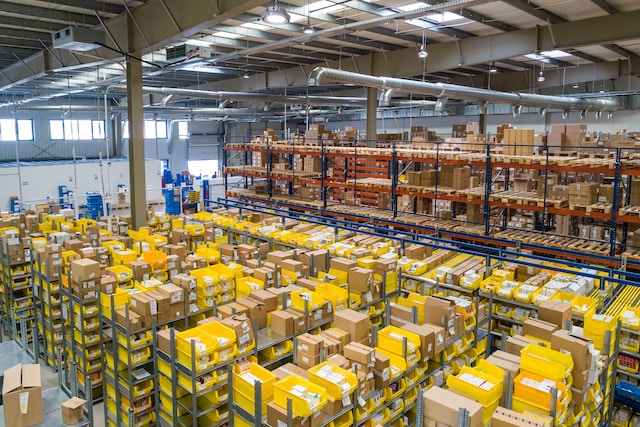
Picture: Unsplash
A successful warehouse must have efficient manufacturing processes to guarantee on-time delivery and satisfied customers. This guide provides five key strategies to enhance production operations, optimize workflow, and maximize overall efficiency.
1: Optimize Layout and Workflow
Enhancing warehouse efficiency involves a critical assessment and optimization of layout and workflow. Businesses should evaluate the warehouse layout to minimize travel distances and strategically organize inventory. This strategic organization ensures easy access to frequently picked items, reducing the time required to fulfill orders. An organized layout not only minimizes the physical effort required but also enhances overall productivity by streamlining workflows. This optimization is especially crucial in high-traffic areas, where efficient movement and accessibility contribute significantly to operational effectiveness. Employing innovative solutions like mobile shelving or automated storage systems can further optimize space and improve the overall layout, fostering a seamless workflow. Companies that place a high priority on the strategic layout of their warehouse space are better positioned to rapidly fulfill consumer requests and keep a competitive advantage in the marketplace.
2: Streamline Inventory Management
Businesses must streamline their inventory management processes. Implementing robust inventory tracking systems, incorporating barcode technology, and conducting regular inventory audits are key components of an effective strategy. These measures contribute to maintaining accurate stock levels, minimizing errors, and promoting overall organizational efficiency. When considering tools to enhance inventory management, businesses may explore innovative solutions such as utilizing an industrial computer cart. These carts provide a mobile and technology-enabled platform that integrates seamlessly with inventory systems, allowing for real-time updates and tracking. Incorporating these carts into the inventory management framework can further elevate accuracy and responsiveness, contributing to a more streamlined and efficient operational workflow.
3: Invest in Technology Solutions
To stay competitive in the modern business landscape, investing in technology solutions is essential for optimizing warehouse efficiency. Traditional warehouse operations are being transformed in large part by automated picking systems, real-time tracking technology, and warehouse management systems (WMS). WMS, for instance, provides a comprehensive platform for managing inventory, orders, and logistics, allowing for centralized control and real-time visibility into warehouse activities. Automated picking systems utilize robotics or automated guided vehicles (AGVs) to streamline the order fulfillment process, reducing manual handling and minimizing errors. Real-time tracking technologies, such as RFID or barcode systems, enable precise monitoring of inventory movements, enhancing accuracy and responsiveness. Embracing these technologies not only reduces manual errors but also contributes to a more streamlined production process. Businesses that invest in such technology solutions not only improve operational efficiency but also position themselves to adapt to the evolving demands of a dynamic market.
4: Prioritize Employee Training
Prioritizing employee training is a fundamental element for achieving and maintaining efficient warehouse operations. Well-trained staff play a pivotal role in adapting to the latest technologies, understanding safety protocols, and implementing best practices. Investing in regular training programs ensures that employees stay abreast of the evolving tools and methodologies within the warehouse environment. Employees become more adept at using cutting-edge technology like automated picking systems, real-time tracking solutions, and warehouse management systems (WMS) by improving their skills and expertise. Beyond technology, comprehensive training programs contribute to the development of a safety-conscious workforce, reducing the likelihood of workplace accidents and promoting a secure working environment. This commitment to ongoing training not only boosts employee productivity but also fosters a culture of continuous improvement, ensuring that the warehouse team remains adaptable, skilled, and well-equipped to meet the challenges of a dynamic operational landscape.
5: Continuous Process Improvement
To maintain and advance effective warehouse operations, it is imperative to cultivate a culture of continual improvement. Regularly reviewing and analyzing warehouse processes allows businesses to pinpoint areas for enhancement and refinement. Encouraging feedback from staff members who are on the front lines of daily operations provides valuable insights into potential improvements. Monitoring key performance indicators (KPIs) further facilitates data-driven decision-making, enabling businesses to assess the effectiveness of current processes and identify areas requiring attention. By embracing continuous improvement, warehouses can adapt swiftly to changing demands, technological advancements, and industry trends. This proactive strategy guarantees that the warehouse stays responsive and flexible in a changing business environment in addition to improving operational efficiency. Regular process evaluations and a commitment to ongoing refinement empower the workforce to contribute to the evolution and optimization of warehouse operations, promoting sustained success.
Conclusion:
Improving production operations in a warehouse is a dynamic process that requires a combination of strategic planning, technology integration, and ongoing employee development. Warehouses may enhance their operations and boost customer happiness and efficiency by putting these five techniques into practice.


